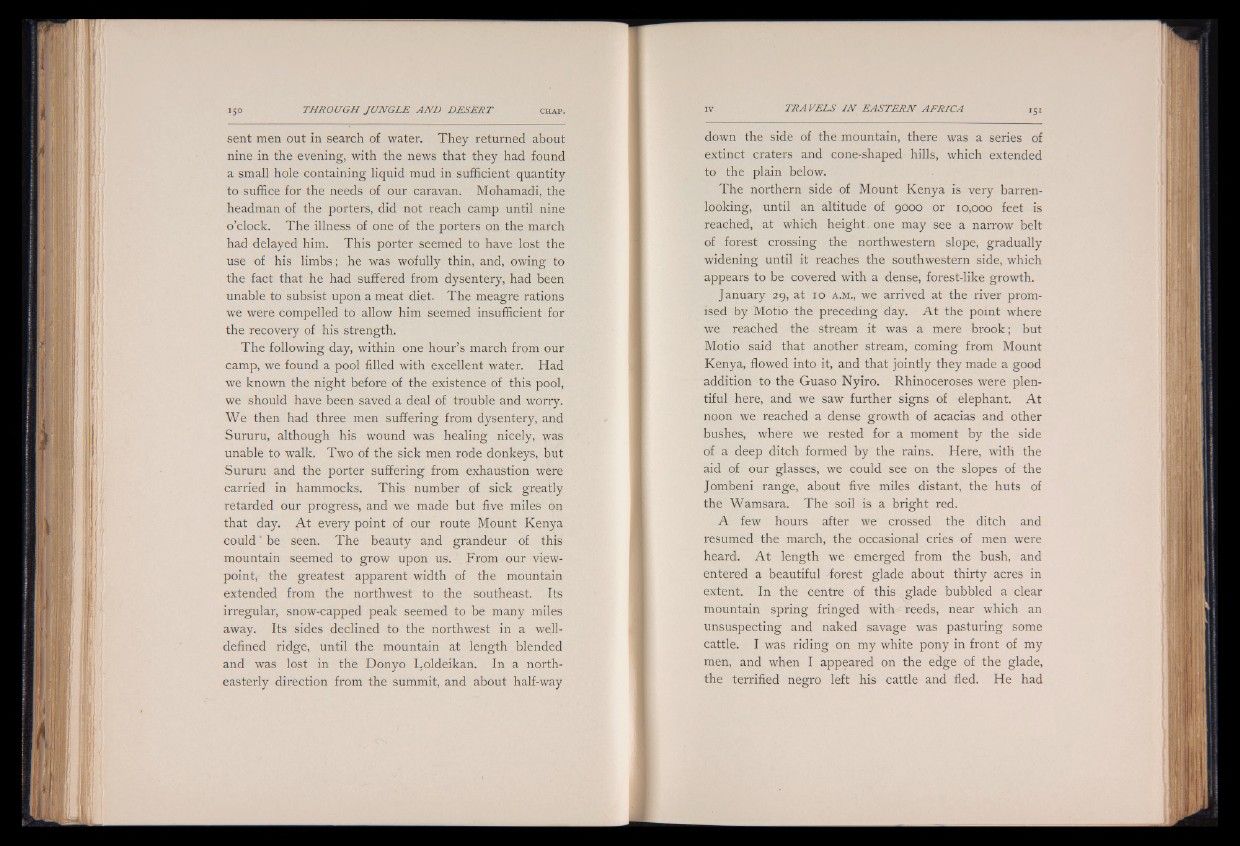
sent men out in search of water. They returned about
nine in the evening, with the news that they had found
a small hole containing liquid mud in sufficient quantity
to suffice for the needs of our caravan. Mohamadi, the
headman of the porters, did not reach camp until nine
o’clock. The illness of one of the porters on the march
had delayed him. This porter seemed to have lost the
use of his limbs; he was wofully thin, and, owing to
the fact that he had suffered from dysentery, had been
unable to subsist upon a meat diet. The meagre rations
we were compelled to allow him seemed insufficient for
the recovery of his strength.
The following day, within one hour’s march from our
camp, we found a pool filled with excellent water. Had
we known the night before of the existence of this pool,
we should have been saved a deal of trouble and worry.
We then had three men suffering from dysentery, and
Sururu, although his wound was healing nicely, was
unable to walk. Two of the sick men rode donkeys, but
Sururu and the porter suffering from exhaustion were
carried in hammocks. This number of sick greatly
retarded our progress, and we made but five miles on
that day. A t every point of our route Mount Kenya
could' be seen. The beauty and grandeur of this
mountain seemed to grow upon us. From our viewpoint,
the greatest apparent width of the mountain
extended from the northwest to the southeast. Its
irregular, snow-capped peak seemed to be many miles
away. Its sides declined to the northwest in a well-
defined ridge, until the mountain at length blended
and was lost in the Donyo Loldeikan. In a northeasterly
direction from the summit, and about half-way
down the side of the mountain, there was a series of
extinct craters and cone-shaped hills, which extended
to the plain below.
The northern side of Mount Kenya is very barren-
looking, until an altitude of 9000 or 10,000 feet is
reached, at whieh height, one may see a narrow belt
of forest crossing the northwestern slope, gradually
widening until it reaches the southwestern side, which
appears to be covered with a dense, forest-like growth.
January 29, at 10 a .m ., we arrived at the river promised
by Motio the preceding day. A t the point where
we reached the stream it was a mere brook; but
Motio said that another stream, coming from Mount
Kenya, flowed into it, and that jointly they made a good
addition to the Guaso Nyiro. Rhinoceroses were plentiful
here, and we saw further signs of elephant. A t
noon we reached a dense growth of acacias and other
bushes, where we rested for a moment by the side
of a deep ditch formed by the rains. Here, with the
aid of our glasses, we could see on the slopes of the
Jombeni range, about five miles distant, the huts of
the Wamsara. The soil is a bright red.
A few hours after we crossed the ditch and
resumed the march, the occasional cries of men were
heard. A t length we emerged from the bush, and
entered a beautiful forest glade about thirty acres in
extent. In the centre of this glade bubbled a clear
mountain spring fringed with reeds, near which an
unsuspecting and naked savage was pasturing some
cattle. I was riding on my white pony in front of my
men, and when I appeared on the edge of the glade,
the terrified negro left his cattle and fled. He had